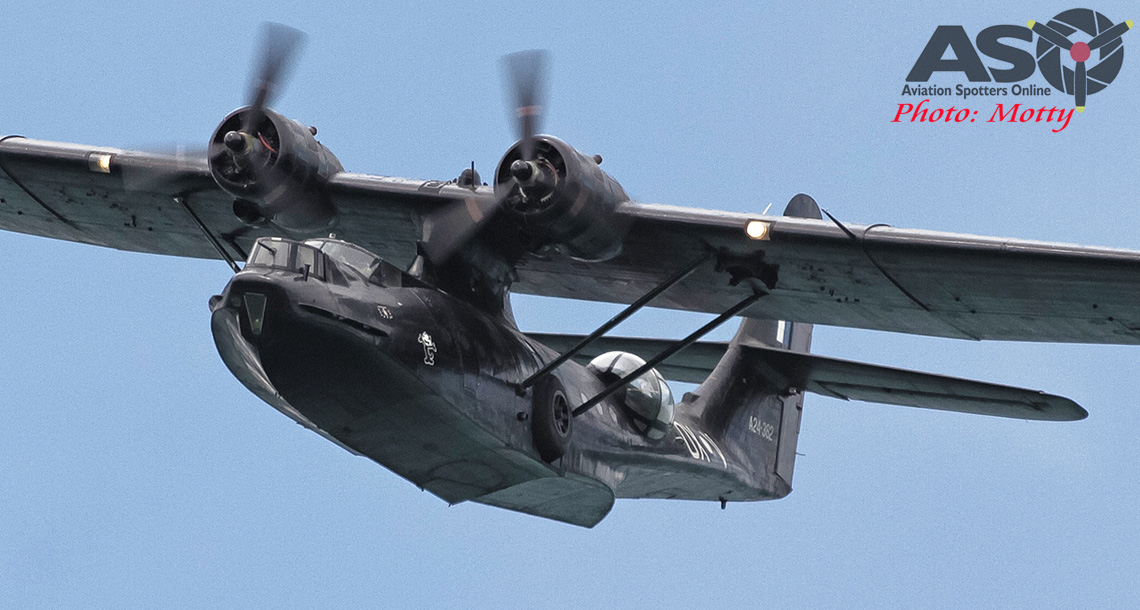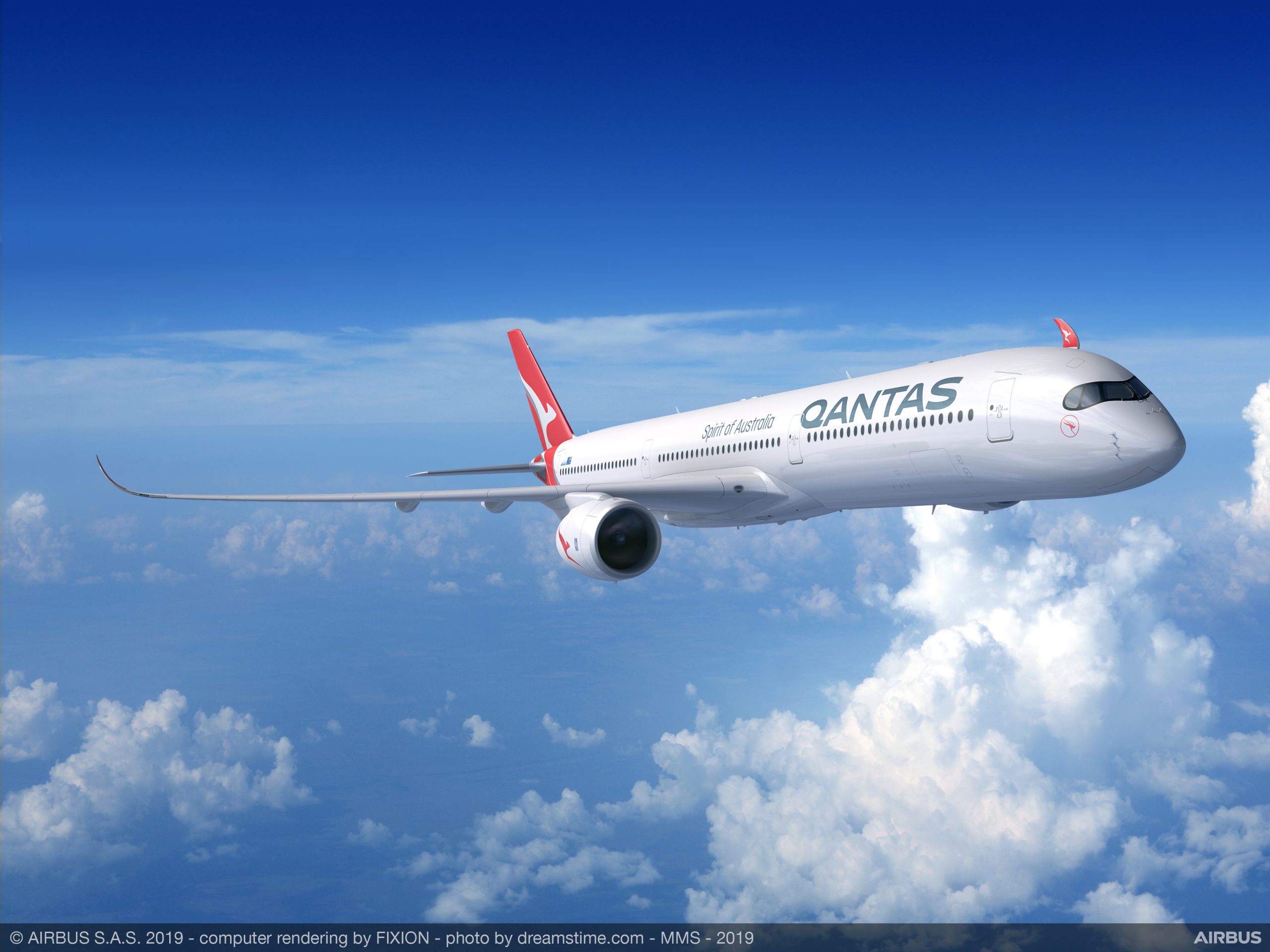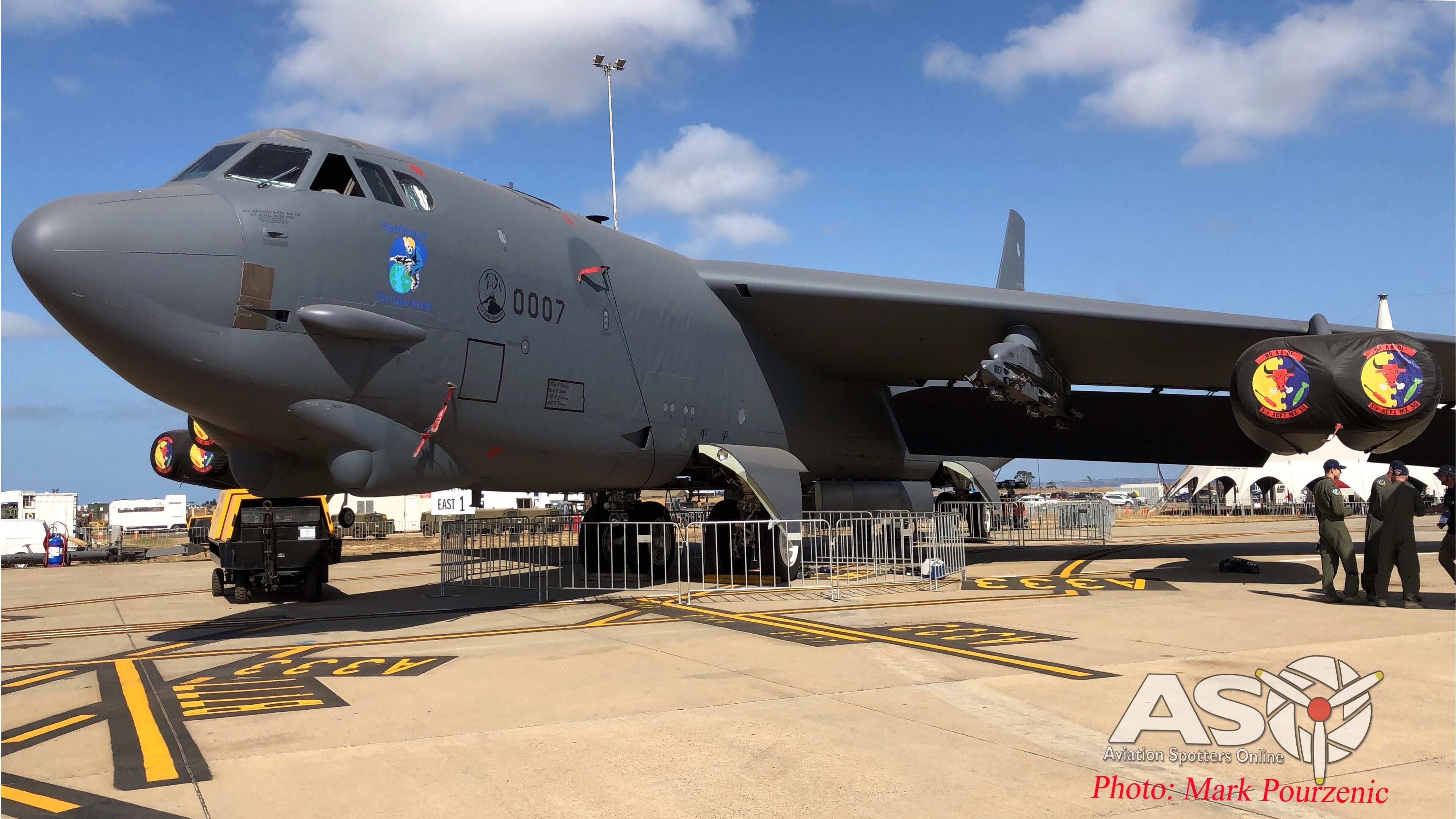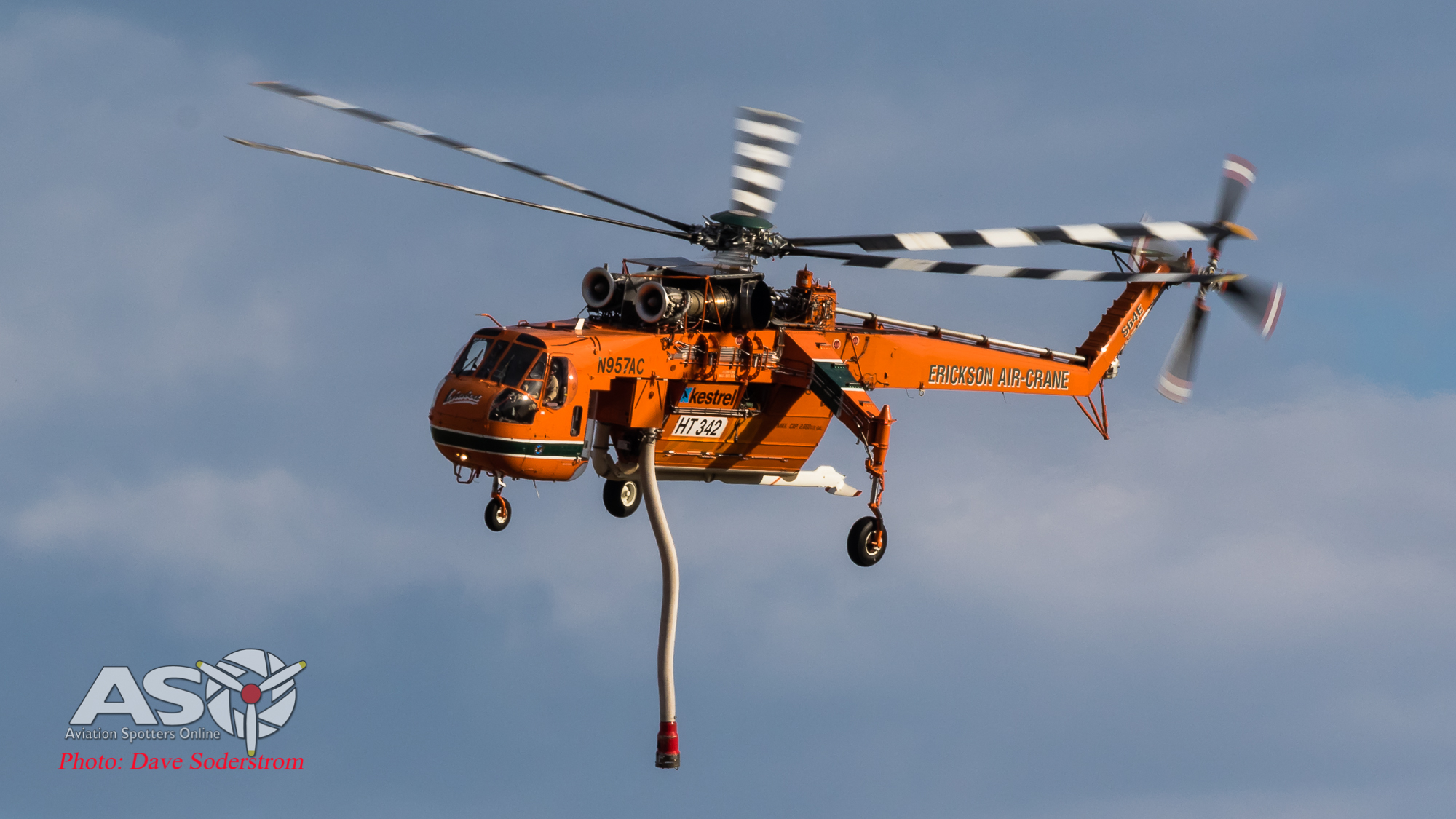Winton, Queensland on the 16th of November 1920, marks the beginning of 100 years of operations for the nation’s national carrier, QANTAS. Aviation Spotters Online would like to show you this shortened and abbreviated history of the airline. Being the third oldest airline in the world, after Dutch carrier KLM, and Colombian carrier Avianca. We salute the men and women of QANTAS throughout the years, and look forward to the next 100 years. Happy Birthday to an Australian Icon.
The Beginning
QANTAS in it’s earliest form was established by its three key founders, World War One veterans Paul McGinness, and Sir Hudson Fysh. They where also joined by Sir Fergus McMaster, the airlines first Chairman. Arthur Baird was also employed as chief aircraft engineer. It was this partnership of aviators whom envisaged an air service connecting Australia to the rest of the world.

Paul McGinness and Sir Hudson Fysh.
Early years
It wasn’t long before it was a reality, as QANTAS soon purchased its first aircraft with operations centralised in Longreach, Queensland. A hangar was built which today still stands to this day. The airlines first aircraft was an Avro 504K that was built in Sydney. At the initial start of the airline, a pair of Avro 504Ks were purchased that were fitted with Sunbeam Dyak engines, with a purchase price of £A1,425 each. The airlines first example still wore its British registration of G-AUBG , and shortly after the pair was joined by another ex great war type, the Royal Aircraft Factory BE2E, wearing the registration G-AUBF.
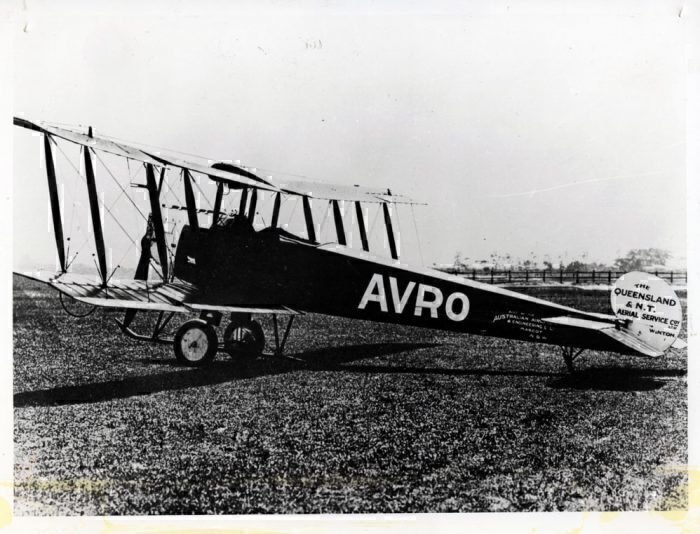
One of the Avro 504Ks is seen at the start of the QANTAS journey to 100 years. (Historic Australian Aircraft Image)
Initially the airline operated predominantly in air taxi & joy flights, with its main operation as an air mail service that was subsidised by the Australian government, linking railheads in western Queensland. Between 1926 and 1928, Qantas built several aircraft at its base in Longreach, making it one of only a very small number of airlines in the world at the time to build its own aircraft.

Royal Aircraft Factory BE2E
Come 1922 and the first scheduled mail and passenger flights from Charleville to Cloncurry occurred in November, with their first passenger being 84-year-old, Alexander Kennedy.
World War Two
During World War Two the airline continued to operate, with a number of its aircraft transferred to the Royal Australian Air Force. The airline continued to operate air services to Singapore and within Australia after war is declared in 1939.
Qantas crews ferried 19 Catalina flying boats from the USA to Australia in 1941, with the first of these flights being the second East to West aerial crossings of the Pacific Ocean.

QANTAS Catalina G-AGKS is loaded for its next flight during the war. (Historical Australian Aircraft Image)
Singapore services cease in February 1942 as Japanese forces occupy most of South East Asia, with Qantas flying boats evacuating servicemen and civilians from the Dutch East Indies to Australia. Sadly, during this time, two Qantas Empire flying boats were shot down by Japanese aircraft in early 1942.
The Qantas hangar and flying boat servicing facilities were destroyed in the first Japanese air raid on Darwin, 19 February 1942.
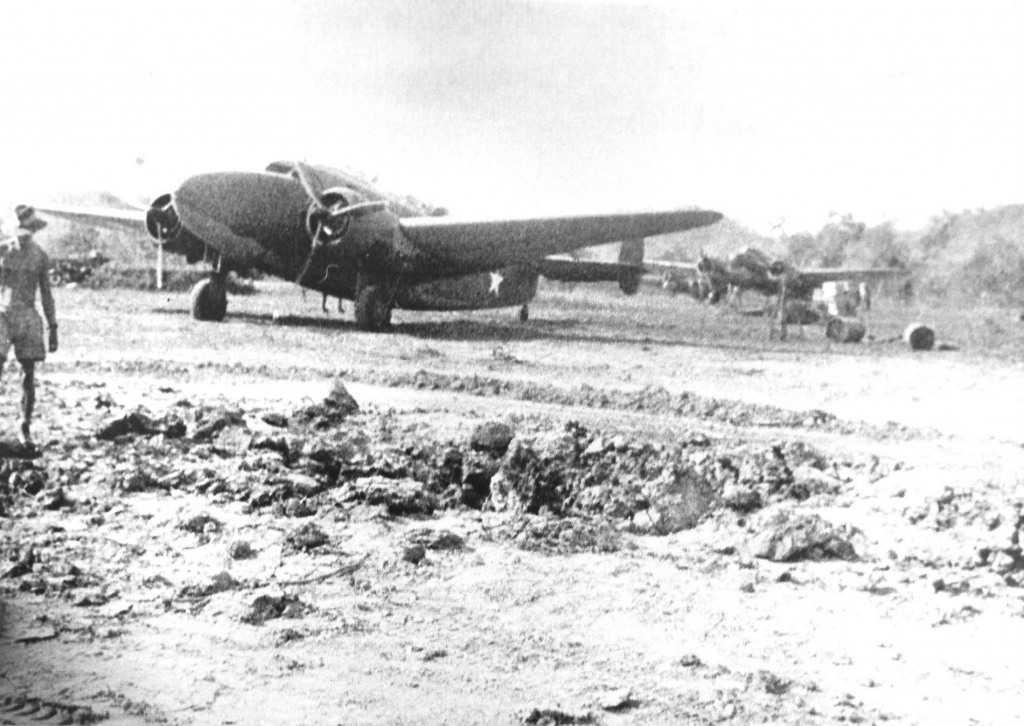
QANTAS operated Lockheed Lodestars, during the war. (Historical Australian Aircraft Image)
Qantas DH86 aircraft evacuate 78 people from Mt Hagen in New Guinea in May 1942.
Qantas completes urgent supply flights from Port Moresby to the front-line at Buna in late 1942.
From June 1943, Qantas operated the only regular air service to Australia across the Indian Ocean between Ceylon and Perth. Catalina flying boats crossed 5,600 kilometres non-stop with flying times of between 28 and 33 hours. Passengers were awarded a certificate of membership to ‘The Rare and Secret Order of the Double Sunrise’.
Liberator aircraft took over in 1945 and passengers received ‘The Elevated Order of the Longest Hop.’ Qantas Liberators were the first to carry the flying kangaroo symbol.
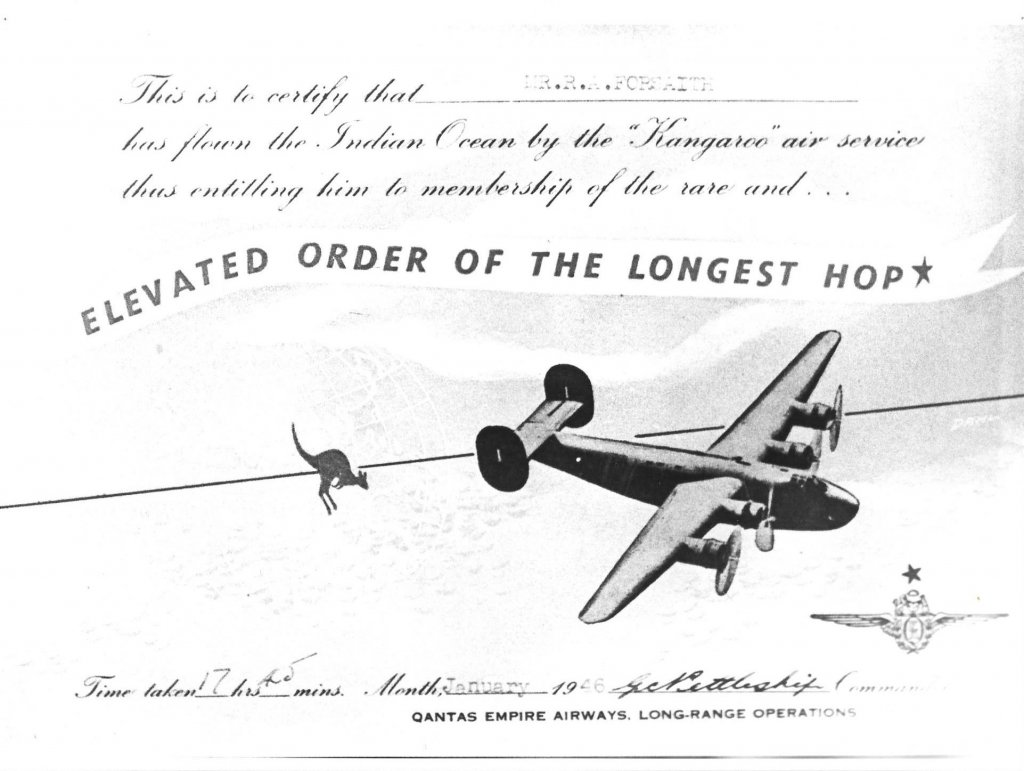
Copy of the ‘Elevated Order Of The Longest Hop’ certificate issued to passengers. (Historical Australian Aircraft Image)

VH-EAJ, an QANTAS LB-30 Liberator is seen at rest. (Historical Australian Aircraft Image)
Post War
In May 1945, QANTAS added its first European destination to its network, that being London. The “Kangaroo route” was served with Avro Lancasters, with 1954 witnessing the airline ushering in Lockheed’s magnificent and super elegant, Lockheed L-749 Constellations.

VH-EAU one of several converted Lancaster Bombers the airline operated as Lancastrians.
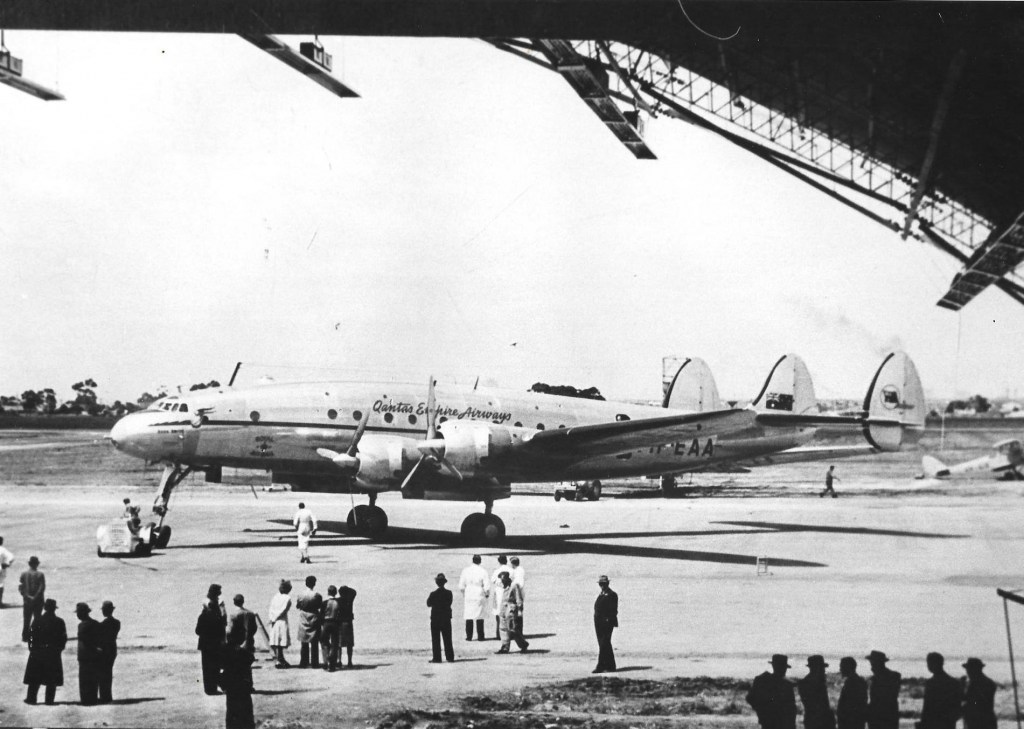
Then brand new, VH-EAA a L-749 version of the Constellation is seen under tow in Sydney. Qantas went on to operate an eventual twenty two Constellations. (Historical Australian Aircraft Image)

The definitive and most attractive version of the Lockheed Constellation the L-1049G is shown here by VH-EAO (Historical Australian Aircraft Image)

VH-EDC is one of twelve DC-3s operated by the airline. This is the aircraft which ditched in Sydney Harbour and was recovered and used in ‘The Pacific’ mini series. Historical Australian Aircraft Image)
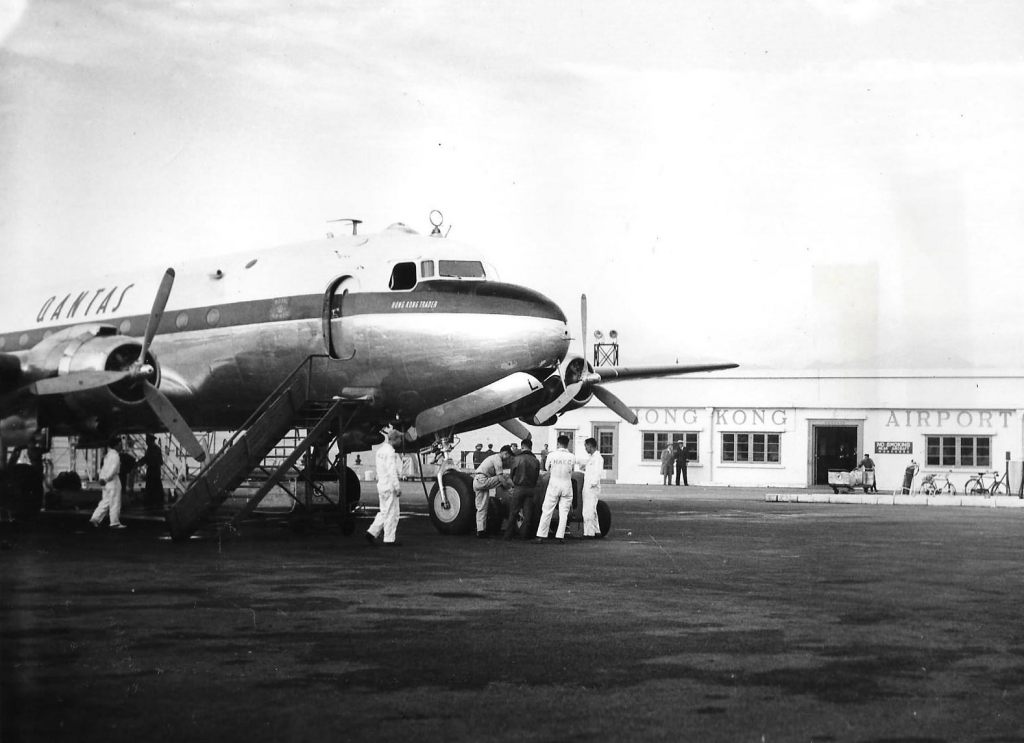
DC-4 VH-EBL is seen at Hong Kong Airport in the late 50’s (Historical Australian Aircraft Image)
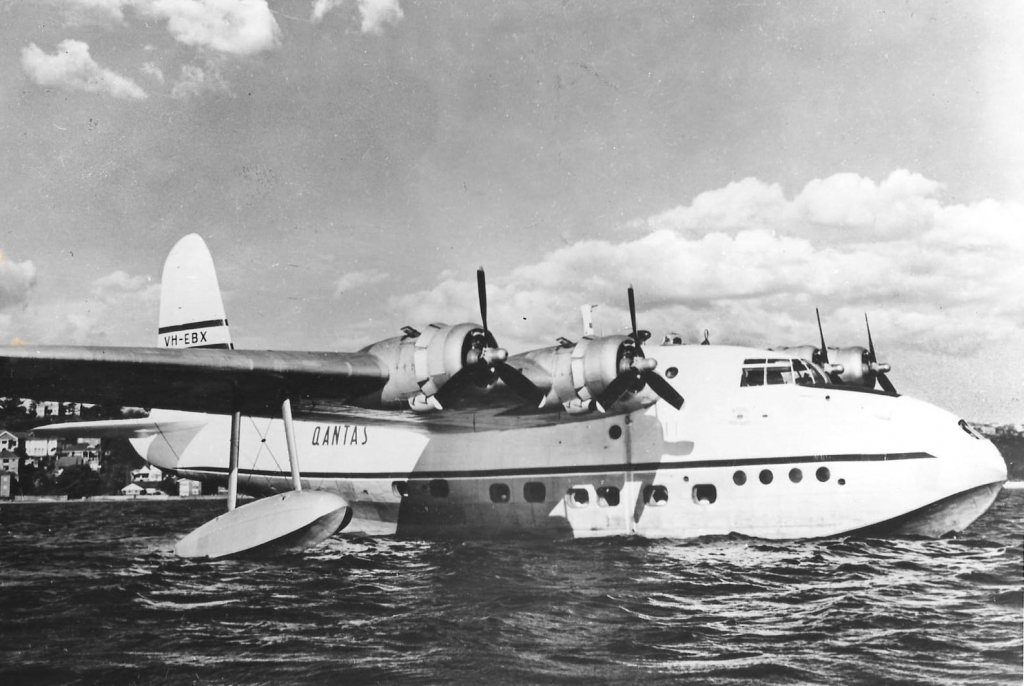
VH-EBX is seen at Rose Bay in Sydney. QANTAS had a long association with the Shorts family of Flying boats. (Historical Australian Aircraft Image)
In 1947, Qantas Empire Airlines or QEA, was nationalised by the Australian government by then Labor Prime Minister Ben Chifley. QANTAS Limited was then wound up. After nationalisation, Qantas’ remaining domestic network, in Queensland, was transferred to the also nationally owned Trans-Australia Airlines, leaving Qantas with a purely international network.
The Jet age beckons.
The jet age was dawning and so was the airlines desire to operate them. It wasn’t long before QANTAS ordered the Boeing 707, much to the detest of the British Government whom wanted the De Havilland Comet procured.
The airline also took delivery of another Lockheed Airliner in 1959, with the first of four Lockheed L-188 Electra PropJets arriving.
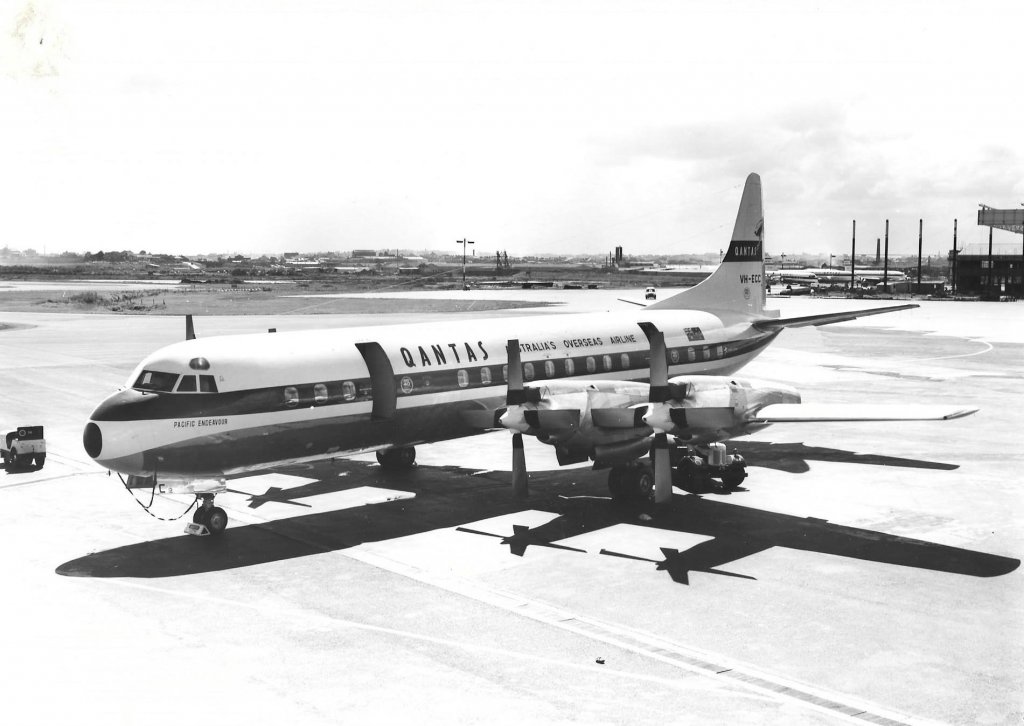
VH-ECC one of four Lockheed Electra’s owned and operated by the airline. Today this aircraft still earns its keep as a fire bomber with Air Spray in Canada as Bomber 484. (Historic Australian Aircraft Image)
QANTAS in PNG
Supplementing operations domestically and internationally was the airlines operations and base in Papua New Guinea.
In March 1950, Qantas started operating Douglas DC-4 Skymasters between Sydney and Lae. Internal operations in PNG were conducted by Qantas and some independent operators, providing regular and charter services throughout the Territory.
Qantas would eventually be forced out of PNG in 1960 by the Australian Government’s Two Airline Policy which decreed that Qantas would fly only on international routes, with TAA and Ansett-ANA awarded the right to operate the Australia – PNG route.

The QANTAS PNG Fleet consisted of Douglas DC-3, De Havilland DHC-2 Beaver and DHC-3 Otter aircraft. (Historical Australian Aircraft Image)
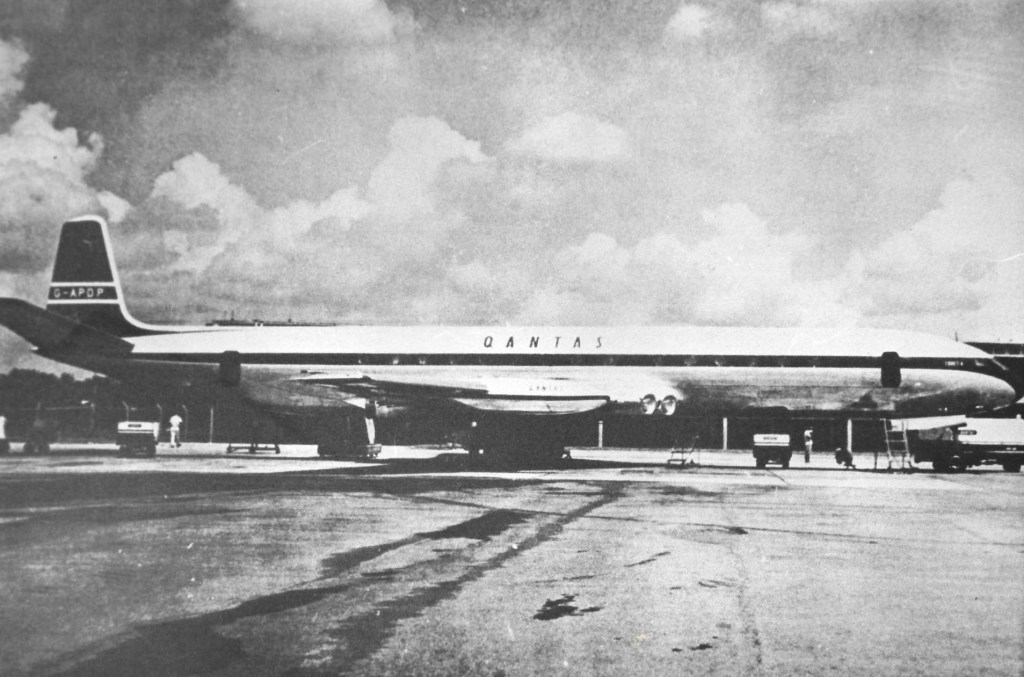
QANTAS did eventually operate the Comet in its later and safer Comet 4 version for a short period. As shown by G-APDP when it was leased to the airline. (Historical Australian Aircraft Image)
April 1959 was when QANTAS took delivery of a brand new Boeing 707-138. The first of an eventful 36 airframes in several different versions.
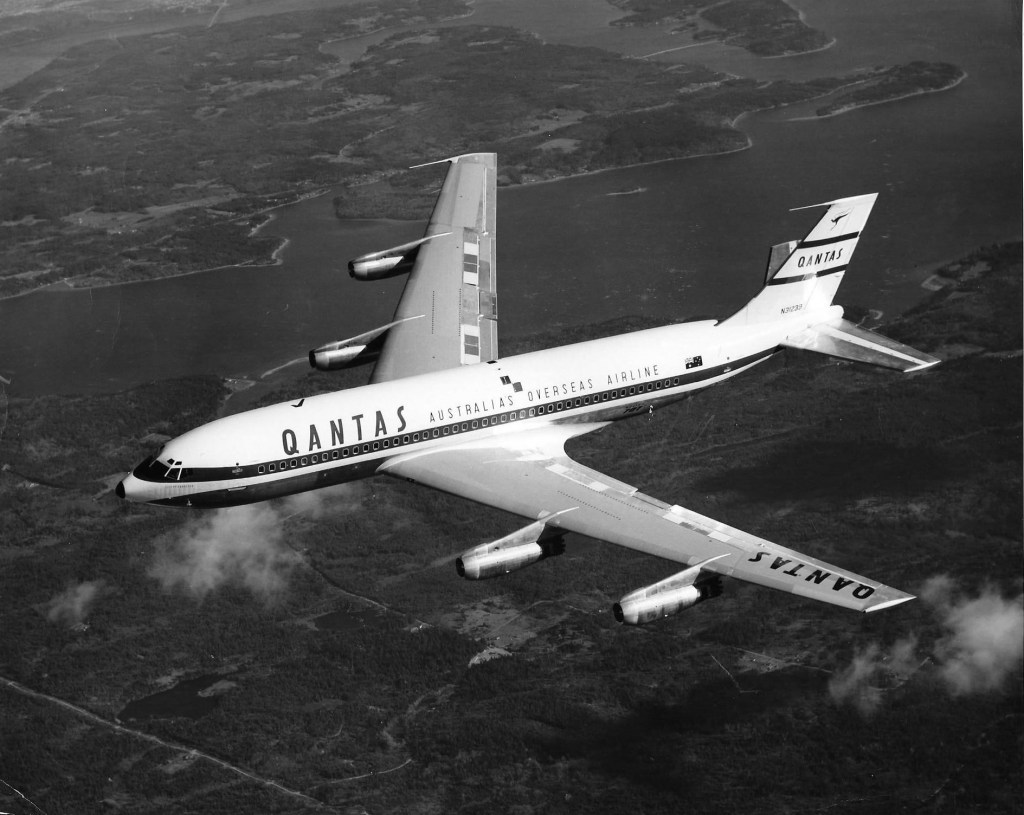
N31239 in pre delivery test markings and registration that would later become QANTAS’s VH-EBA when delivered to the airline. (Historical Australian Aircraft Image)
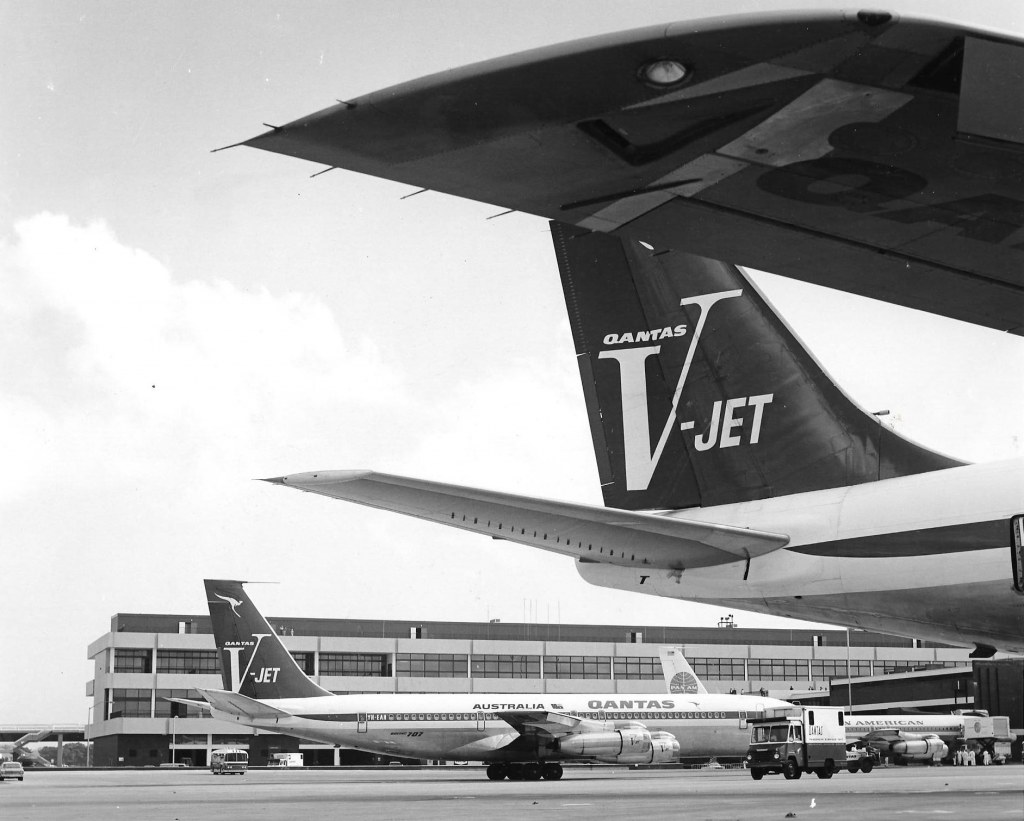
QANTAS 707-338s in the V-Jet livery. (Historic Australian Aircraft Image)
Jumbo Jet years
After the last Boeing 707 was retired in April 1978, QANTAS became an all Boeing 747 operator on its long-haul network to Europe, Southeast Asia, North America, Southern Africa and the Far East. The airline continued its innovation in the skies also, which included the world’s first Business Class cabin introduced in 1979, and the invention of the slide raft by Qantas employee Jack Grant, that is now standard on all large commercial aircraft.
The Airline also broke a record with one of its 747s in 1974. A World record for largest passenger load, evacuating 674 passengers, with 23 crew, on a Boeing 747 after Cyclone Tracy devastated Darwin during the Christmas period.

QANTAS operated the HS-125 to train 747 pilots. (Historical Australian Aircraft Image)
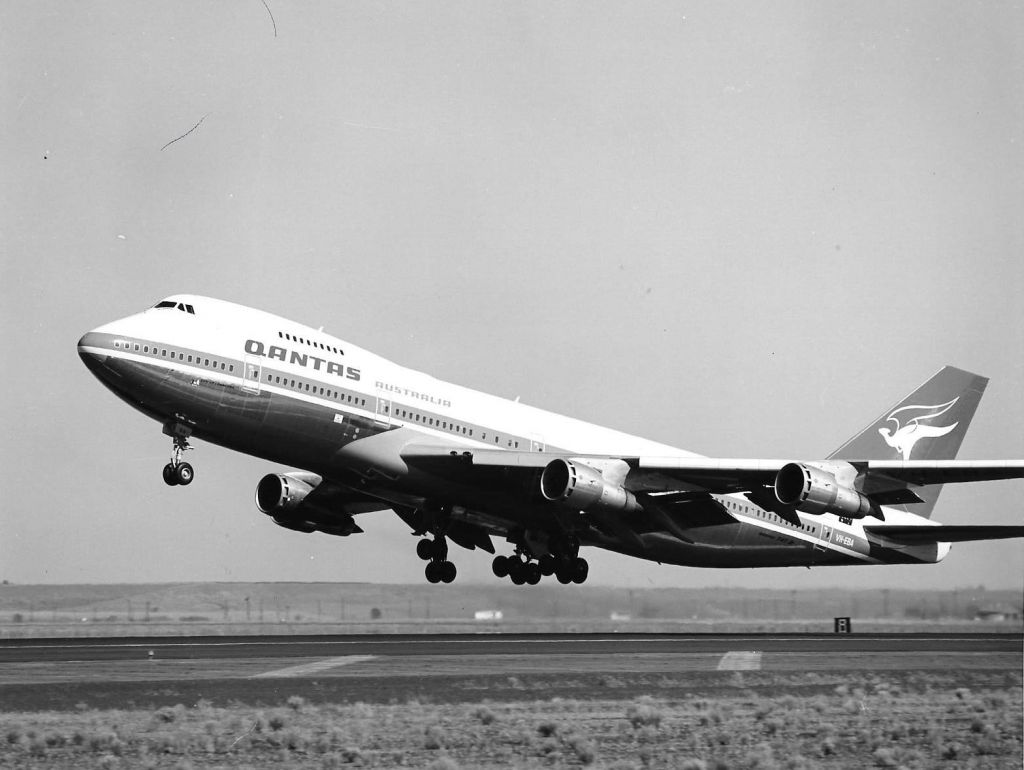
VH-EBA QANTAS’s first Boeing 747-238. (Historical Australian Aircraft Image)
The first QANTAS Boeing 747 example, registered VH-EBA, and named ‘City of Canberra’, a 747-238B was delivered in 1971. the 747 served the airline for a remarkable 49 years of service, with six distinct versions operated. QANTAS has flown and operated the 238B (SCD), SP-38, 238B, 338, 438 and 438ER. Also including some leased 100 series versions.
QANTAS kept its commitment to the 747 when it placed an order for the then latest version of the aircraft, with an initial order for four 747-400s that was placed on March 2, 1987. In August 17 1989, after flying direct to Sydney from London, VH-OJA ‘City of Canberra’ arrived after its record nonstop flight. The 18,001km flight, under the command of Captain David Massy-Greene, took 20 hours, nine minutes and five seconds and established a new world distance record for a commercial aircraft. To read more on the 747 in QANTAS Operations follow this link: http://aviationspottersonline.com/qantass-747-the-queen-of-the-skies/
1980s-2000s
The 1980’s saw another new type enter into the fleet with the arrival of the first Boeing 767-238ER jet. The arrival of QANTAS’s first 767 VH-EAJ, also saw the airline return to domestic operations. The Boeing 767 fleet would eventually reach a total of thirty nine aircraft, and were operated on a mix of domestic and international routes.
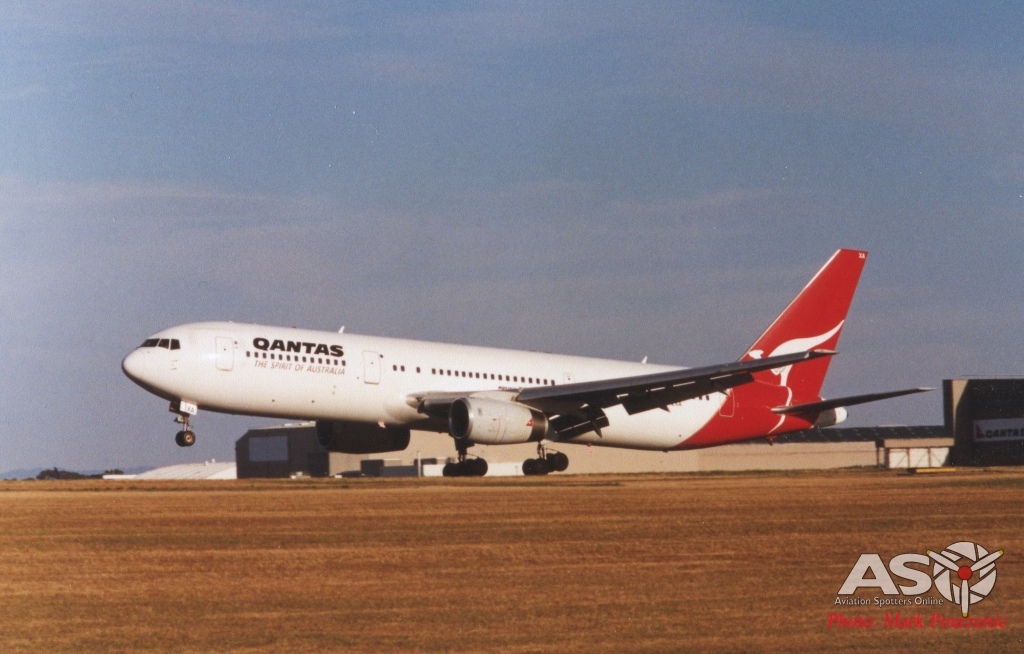
One of seven ex British Airways Boeing 767-336s that QANTAS leased from the former.
On 14 September 1992, Qantas merged with nationally owned domestic airline Australian Airlines (renamed from Trans-Australia Airlines in 1986). The blue roo, started to be rebranded to Qantas in the following year, with this merger seeing a host of new types added to the QANTAS arsenal. This included the Airbus A300, Boeing 737-300/400, BAe-146, Bae Jetstream 31, Cessna 404 Conquest, and the De Havilland DHC-6 Twin Otter. The newly added fleet over time gained QANTAS branding, with the airline gradually becoming privatised during 1993 and 1997.

VH-TAA one of four A300s inherited from Australian Airlines. (Historical Australian Aircraft Image)
This wasn’t the end of the Australian name though, as during 2002, Qantas launched its new international subsidiary airline under the name of ‘Australian Airlines’.
Another big change for Qantas came when it created the budget airline Jetstar in 2001, to compete with new entrant Virgin Blue, that was also vying for its place on Australian domestic routes.
During the year 2001, another competitor in the name of Impulse Airlines, also rose to the occasion for inclusion into the regional and low cost trunk services offered by the previous mentioned carriers. Impulse in both forms operated between 1992 and 2004, before finally being acquired by Qantas to form the basis of a new regional airline, known as QantasLink.
More 747s for QANTAS
Rolling off the production line at Everett in the Boeing House livery as ‘N6018N’, on June 6th 2002, was the first 747-400ER (Extended Range) built by Boeing. Powered by General Electric GE CF6-80C2B5 engines, it was delivered to QANTAS as VH-OEE, and delivered to the airline at Avalon Airport in 2002. QANTAS was the only airline to order the ER version of the 747-400.
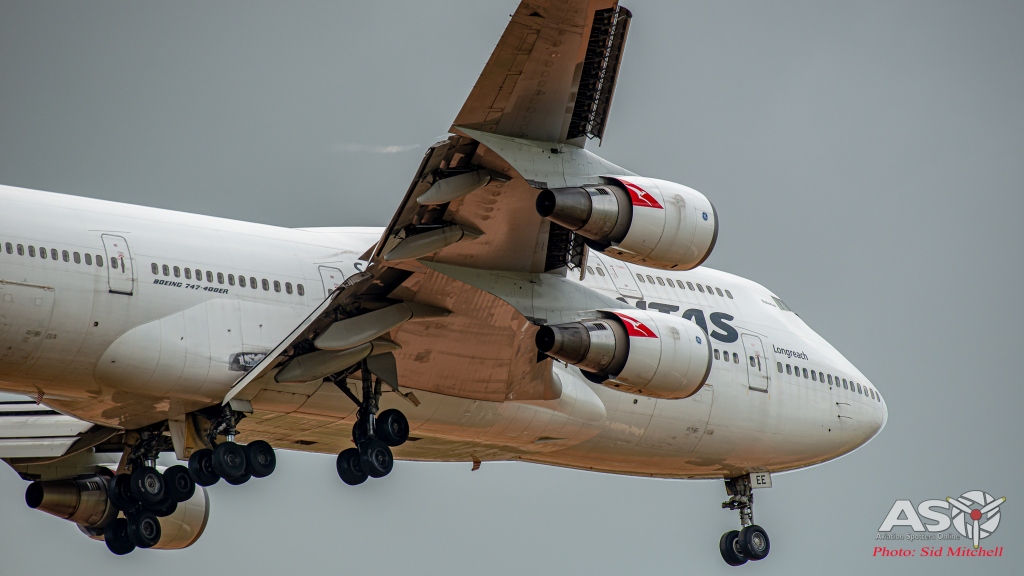
QANTAS Link
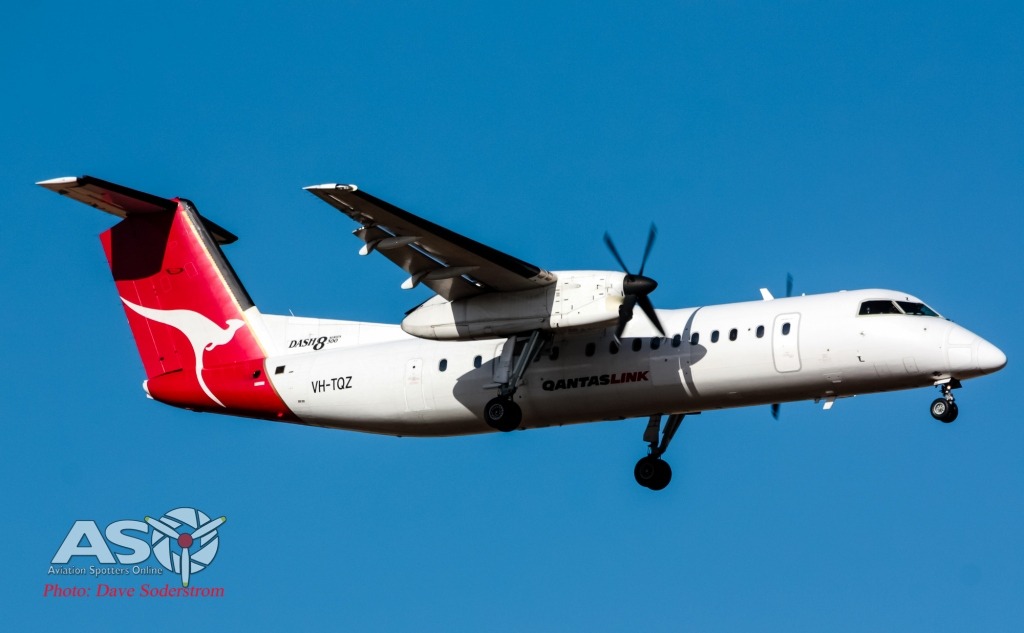
VH-TQZ, seen in its QANTASLInk livery.
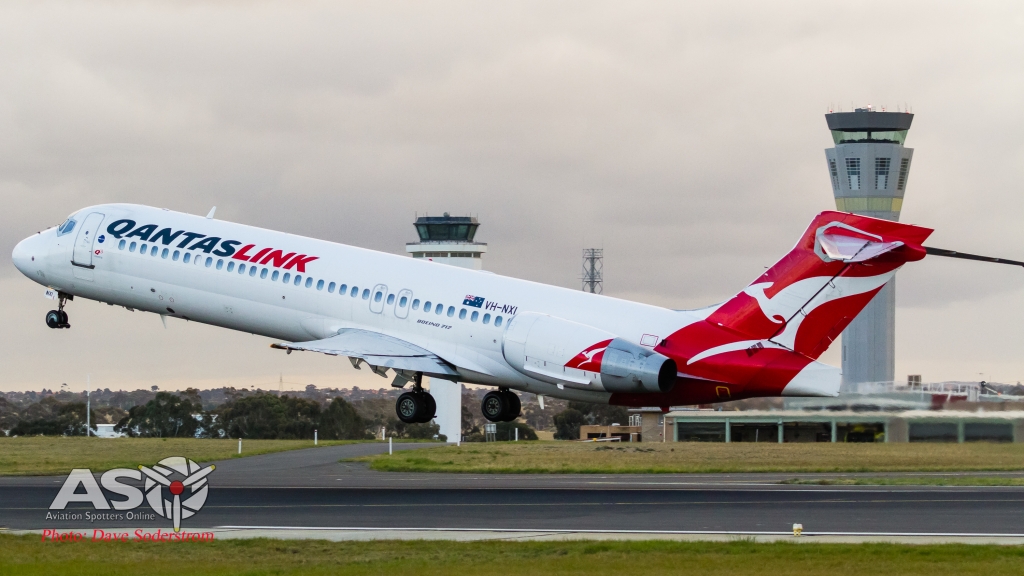
VH-NXI is one of twenty in the fleet.
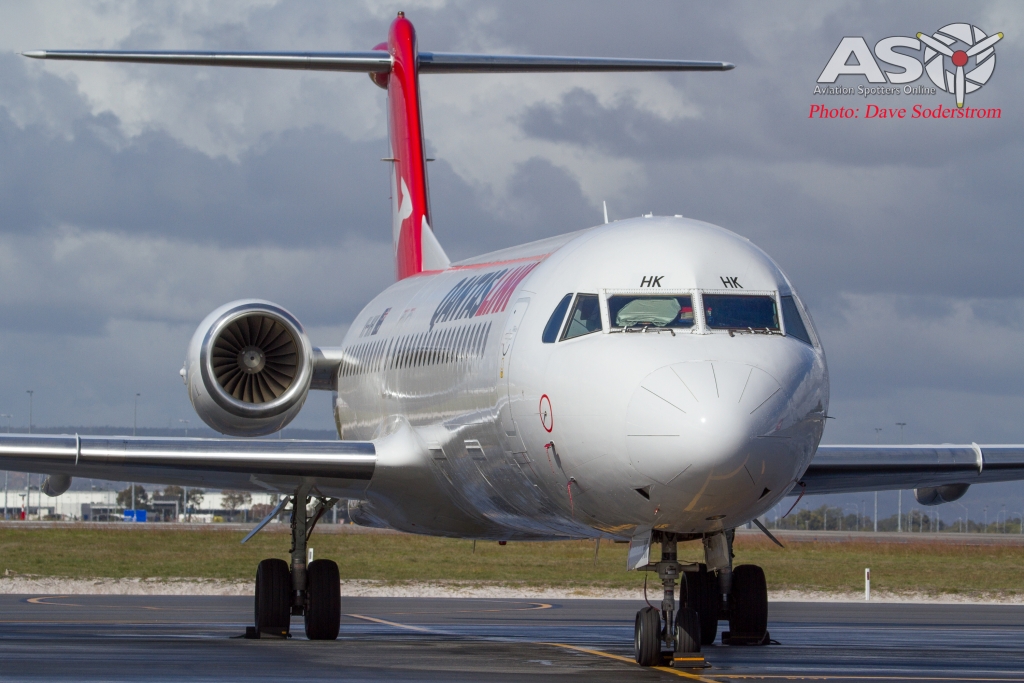
VH-NHK is one of eighteen F-100s in the fleet.
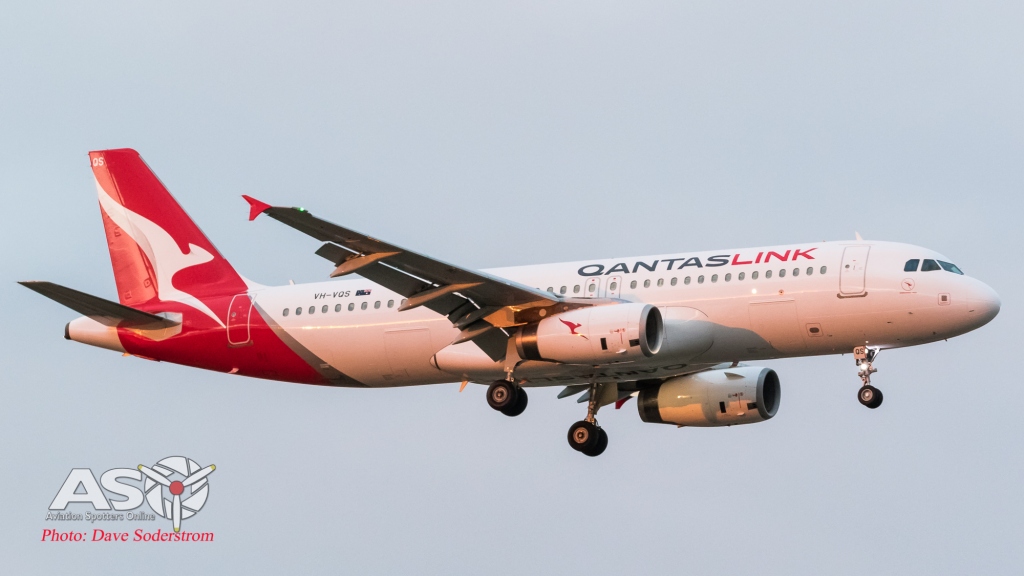
Fleet upgrades for the future
The airline has added some further credits its long list of firsts with the arrival of the Boeing 787-9 in its fleet. Boeing 787 Dreamliner VH-ZNA, arrived into the airlines service in 2017. With the delivery of theses long haul jets came QANTAS’s push to provide ultra long haul routes for its potential passengers.
On the 2nd of May 2018, the airline announced an order for an additional six Boeing 787-9s to fly on its international network, bringing its fleet of Dreamliners to 14, by the end of 2020.
On 25 March 2018, one of the airlines 787s became the first aircraft to operate a scheduled non-stop commercial flight, between Australia and Europe, with the inaugural arrival in London of QF9. Flight QF9 was a 17-hour, 14,498 km (9,009-mile) journey from Perth Airport in Western Australia, to London, Heathrow.

VH-ZNA arrives at Melbourne Airport for the first time.
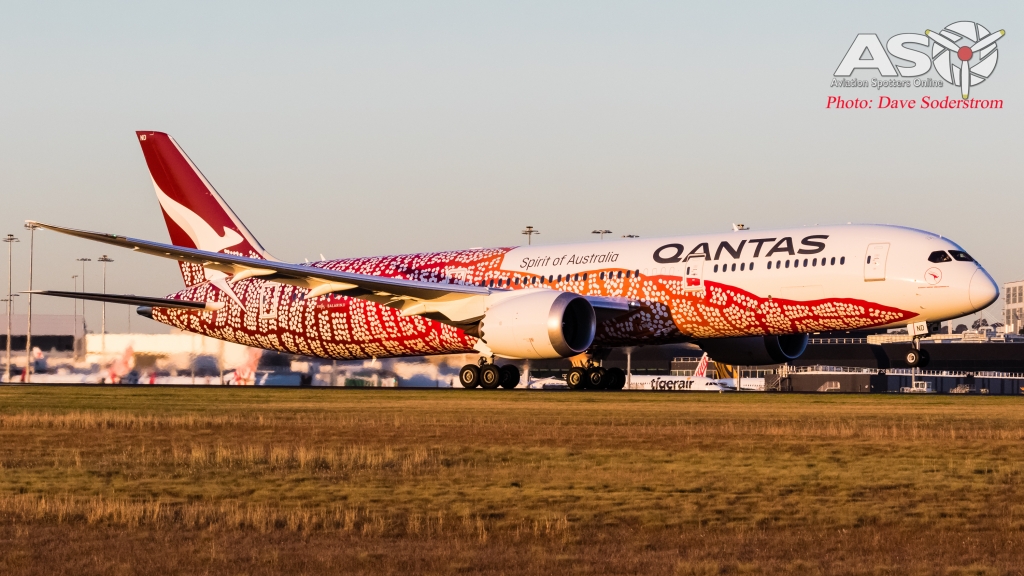
VH-ZND is in a Aboriginal theme livery. Named Emily Kame Kngwarreye.
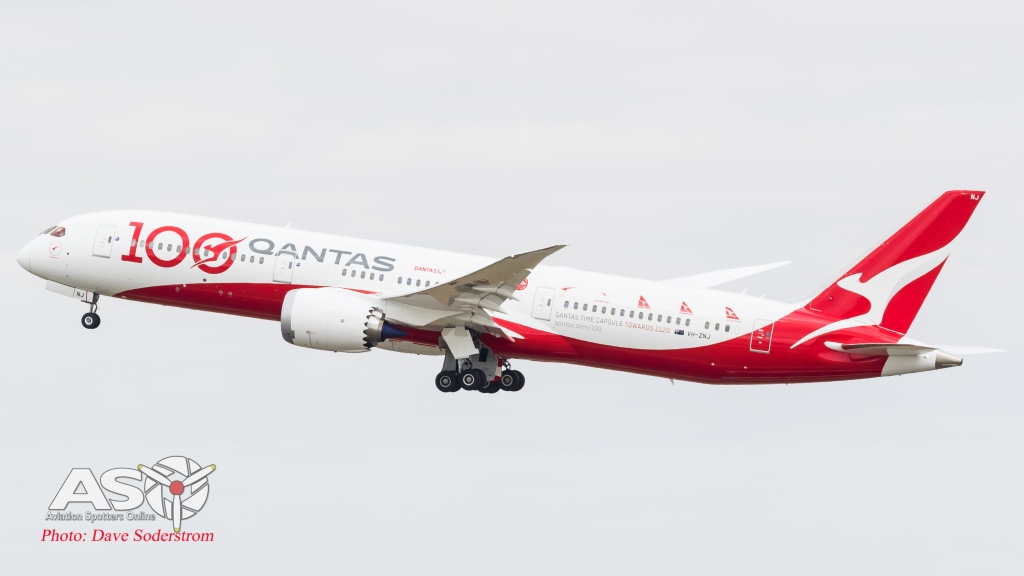
To celebrate 100 years of flying VH-ZNJ was painted in this livery.
On the 1st of February 2019, it was announced that QANTAS had acquired a 19.9 per cent shareholding in Alliance, and that it intended to subsequently seek regulatory approval to acquire a majority position.
On 20 October 2019, Qantas Airways completed the longest commercial flight to date between New York and Sydney, flying its Boeing 787-9 Dreamliner in 19hr 20mins.
It was announced in December 13 2019, another new type was set to carry the airlines kangaroo across the world. This time it was an Airbus product, with the airline selecting the Airbus A350-1000ULR for Project Sunrise. This is part of the airline’s plan to launch new nonstop flights from Sydney to New York, and London that would be the amongst the longest flights in the world.
On the 13th of May 2020, the airline announced it would be pushing back aircraft deliveries for as long as the COVID-19 pandemic persists.
Post Covid-19
Today, the airline as with other airlines, is a shadow of its former self as the effects of the COVID-19 pandemic are felt across the world by all airlines. With International travel halted until at least early 2021, the airline has taken the position to store most of its long haul fleet.
The Boeing 747s have been retired early sadly, and the 747s replacement, the Airbus A380 has seen all twelve flown to the United States, and parked at the Southern California Logistics facility at Victorville, for long term storage. These are unlikely to re-fly until at least 2023, with the airlines fleet of Boeing 787s fairing a little better.
The airline maintains several aircraft in storage in Australia, for repatriation flights on behalf of the Australian Government. Off late, the 787s have operated flights to bring home stranded Australians from England, India and South Africa.
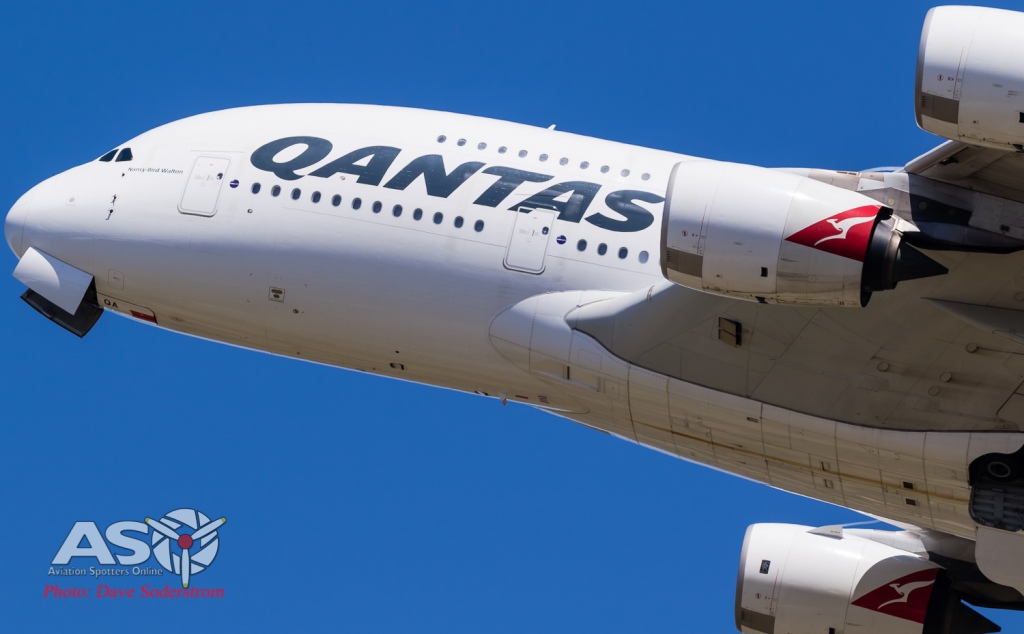
VH-OQA is the first of twelve A380s to fly with the airline.

VH-ZNK operating a repatriation flight into Darwin from Heathrow Airport.
The fleet mix post Covid is understood to include the following:
Boeing 737-800 x 75, Airbus A330-200 x 18, Airbus A330-300 x 10, Boeing 787-9 x 12, Airbus A380 x 12 and should the order progress 12 x Airbus A350-1000ULRs.

VH-XNJ is painted in another Aboriginal theme scheme. This one is named ‘Mendoowoorrji’. The 737 is one of 75 owned by the airline.
Livery through the years
The QANTAS livery is a part of the airline that has evolved through the years. It is still the big kangaroo in the skies, and is recognised across the world as the symbol of the airline, but also Australia. The ‘Spirit of Australia’ titles only reinforce this message as you board the air stairs up to the aircraft. The flying kangaroo first appeared in 1930, when the logo got its wings, taking the airline through its early years in the lead up to becoming an international airline. The Flying Kangaroo design was based on the Australian penny coin, and first appeared in 1944 as a nod to the international Kangaroo Service.
In 1968, when the Boeing 707s were flying passengers around the world, the then new, red kangaroo logo with wings adorned the aircraft. It wasn’t until 1984, that the Flying Kangaroo lost its wings, until the logo was revised in 2007, with some design tweaks in 2007. This was in part due to the A380, and where the Kangaroo would sit on the aircrafts tail. In 2016, the current logo was launched, with a contemporary streamlined look to symbolise a new era.
QANTAS Freight
QANTAS Freight is a wholly owned subsidiary of the Airline. Today the division has grown considerably to capture the local freight market and of course internationally. Operated under a subsidiary banner, called Express Freighters Pty Ltd. The owned and operated aircraft include, Boeing 737-300F x 4, Boeing 737-400F x 1, Boeing 767-300F x 1 and Airbus A321F x 1.
Across the Cargo routes are a wide variety of aircraft, which includes both owned, and leased aircraft. Starting at the smaller end are a fleet of BAe-146 aircraft, which are operated and crewed by South Australian owned, Cobham Aviation Services. At the top end of the scale is the two Boeing 747-8Fs, that are currently leased from Atlas Air, that form part of the long haul freight routes internationally, from Australia. In recent times, QANTAS Freight has introduced the worlds first Airbus A321F, to the expanding fleet.
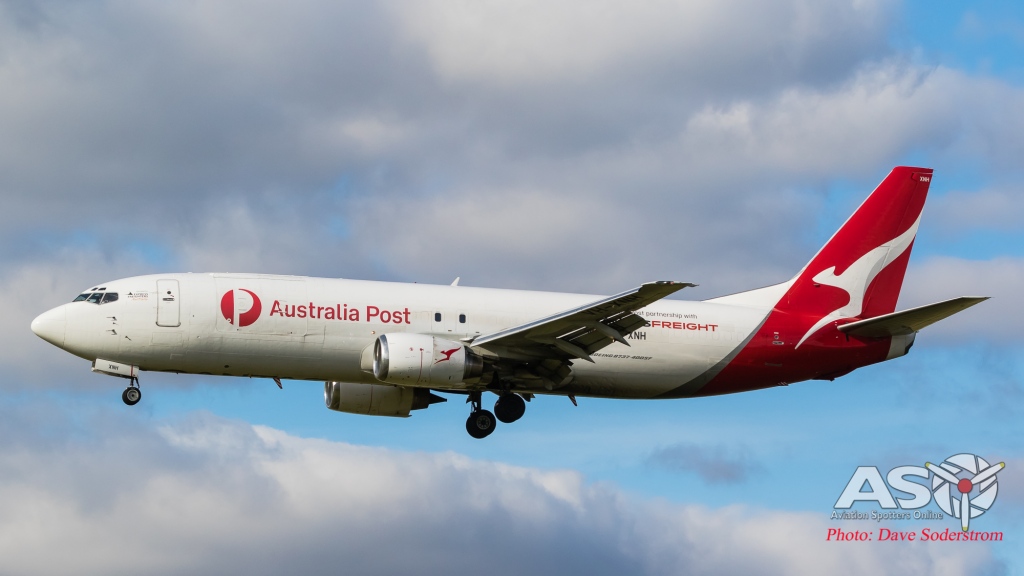
VH-XNH is the sole 737-400F in the fleet.

Recently delivered is Airbus A321F VH-ULD.
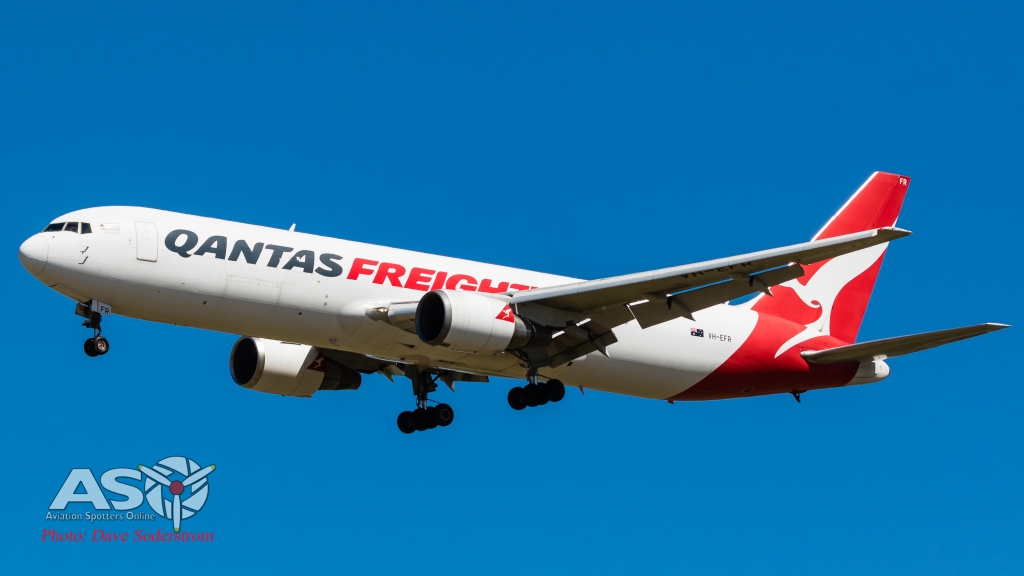
The sole Boeing 767-300F earns its keep flying to destinations all arcs the Pacific.
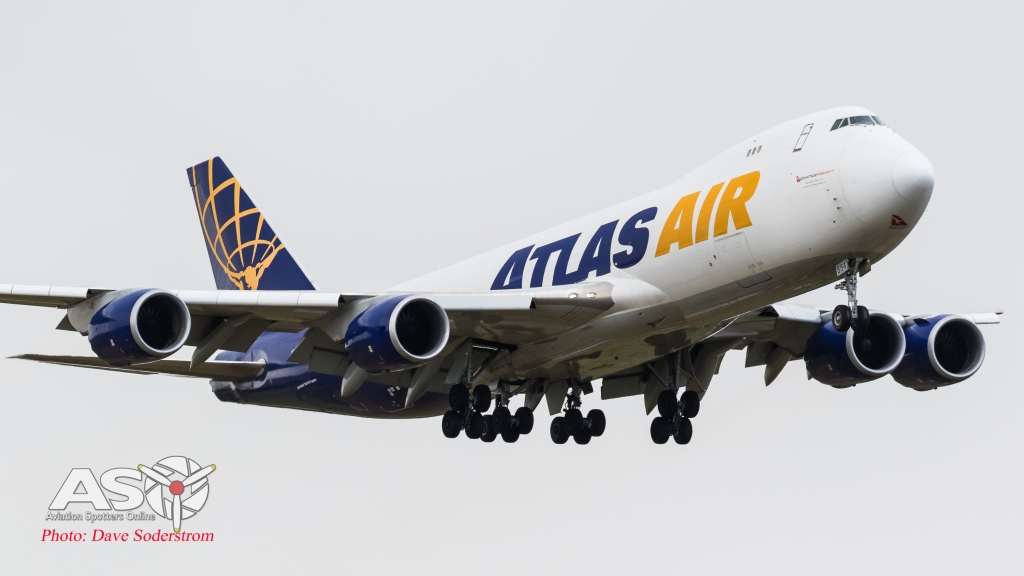
One of two leased Atlas Air Boeing 747-8Fs.
So to the people of QANTAS, Happy Birthday. While it is very tough in these trying times be proud of you heritage as it shows when ever I fly on the airline.
Dave


